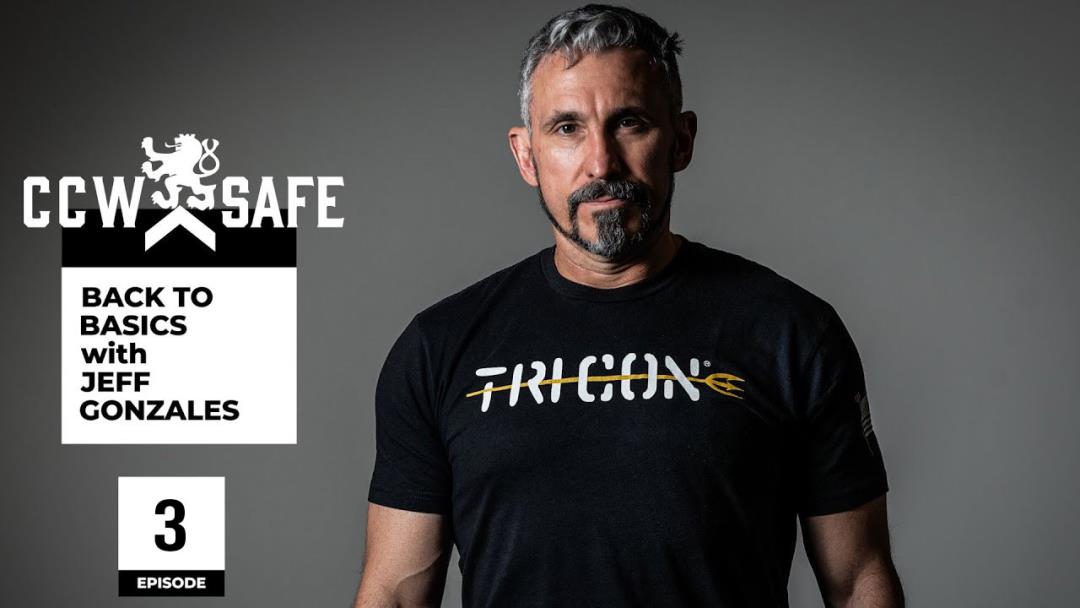
Posted on September 6, 2021
Back to Basics with Jeff Gonzales Episode 3: Safe Firearm Storage
VIDEO – Back to Basics with Jeff Gonzales Episode 3: Safe Firearm Storage
CCW Safe is proud to present the Back to Basics video series with Jeff Gonzales of Trident Concepts. This series focuses on the fundamentals and basics of concealed carry.
In Episode Three Jeff provides a brief overview of the basics of safe firearms storage.
Transcript:
Jeff Gonzalez: Hi, I’m Jeff Gonzalez, president of Training Concepts. I’m here for Back To Basics with CCWC. Today, we’re going to talk about safe firearm storage, and we’re primarily talking about safe firearm storage in the home. The first thing we want to talk about is what is the condition of the firearm? There’s a lot of conditions and if you’re new to firearms and you’re new to storing firearms, your first thing you want to do is want to find out whether or not you want to store that firearm loaded or unloaded.
You’ve got to really think about it. What am I going to really be relying on this firearm for? Home defense? Do I need to be able to get to it quickly and if so, do I want to struggle with the idea of charging the firearm so that it is actually ready to go? That leads us into a question that you have to start to answer. There are basically four ways that you can load or four different conditions for the firearm. Depends on what type of firearm you have but most firearms that are being purchased right now are strike-fired firearms.
That means I have loaded the firearms so that there’s a round in the chamber and a loaded magazine in the gun. That’d be condition one. Condition two; there’s no round in the chamber, but there’s a loaded magazine. Condition three; no round in the chamber, no magazine in the gun. You can see that there’s like a descending level of readiness based off of what condition you choose. Give it some thought, figure out what’s going to work best for you.
The next thing is location, where do I want to store this firearm? Most likely places is going to be in the master bedroom. That makes a lot of sense, but is that going to be readily available during the daytime where at night, it makes a lot of sense, cause that’s where we’re sleeping, but during the day, is that the best place? It’s the kind of thing that you want to talk about and ask yourself.
Next, we just start to talk about readily available, ready, readily accessible. What does that mean? Well, there’s all different types of storage options. You’ve got your old school big safes that you lock everything up in. You’ve got some lockers that are a little less secure. You’ve got these convenient little volts that can be hidden in drawers or attached to the side of the bed. You’re going to have to figure out where you want to secure those firearms, and how much accessibility do you want? Do you want it to be quick or do you need it to be secure? You’re going to have to walk a fine line there.
Next, and this is the most important thing, everything that we’re talking about is leading us to this. All of our actions, all of our choices and equipment, all center around denying unauthorized access. Our goal is to prevent those that should not have access to firearms from gaining access to firearms. You really want to think about how you’re going to array your equipment, the locker you choose, the location, and all that other stuff. Now, that’s the goal.
The next thing we want to talk about is have you given thought to how you’re going to access it during the daytime and at night? Most of the time we think about daytime and it’s easy because I can see what I’m doing. If I need to go in there and punch a code, I can see the code. If I need to go ahead and turn the dial, I can see the dial, but what about nighttime, right? If we’re in our beds in the middle of the night and we hear a commotion and we’re going to go and investigate that commotion with a firearm and we have to gain access, can you even do that? That leads us up to the last thing, which is practice.
I know it sounds silly. Practice being able to access that firearm, practice being able to bring the firearm into a ready condition. Practice all of this because what you don’t want is you don’t want to be under stress or to be woken from a deep sleep and try to figure this all out right then and there. Hopefully, these little techniques, these little tips are going to help you in properly securing your firearm to prevent unauthorized access. I’d love hearing your questions or comments. I’m Jeff Gonzales. Until then, take care and stay safe.